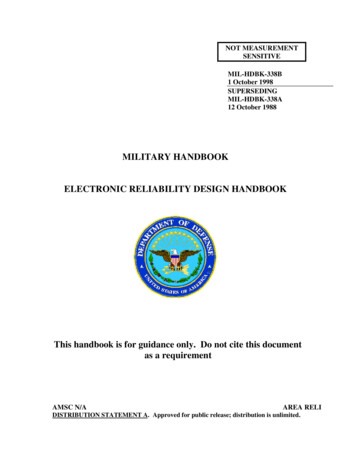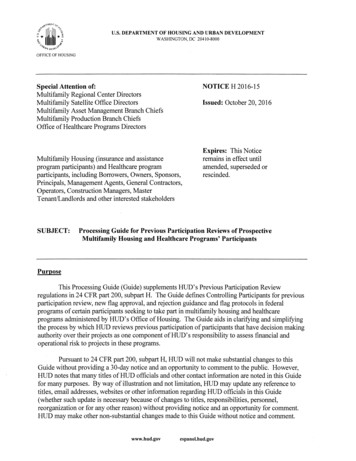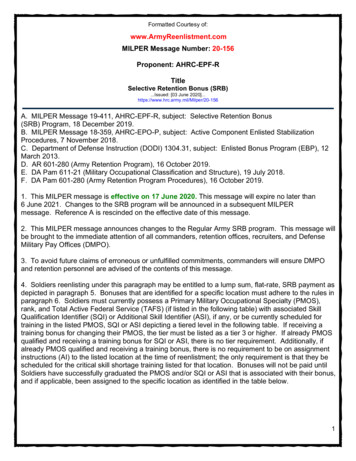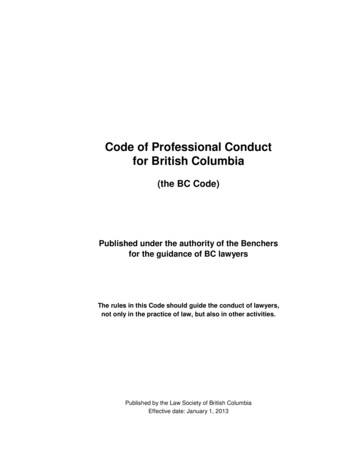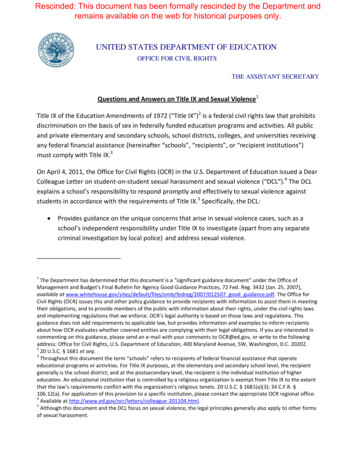
Transcription
Rescinded: This document has been formally rescinded by the Department andremains available on the web for historical purposes only.UNITED STATES DEPARTMENT OF EDUCATIONOFFICE FOR CIVIL RIGHTSTHE ASSISTANT SECRETARYQuestions and Answers on Title IX and Sexual Violence1Title IX of the Education Amendments of 1972 (“Title IX”)2 is a federal civil rights law that prohibitsdiscrimination on the basis of sex in federally funded education programs and activities. All publicand private elementary and secondary schools, school districts, colleges, and universities receivingany federal financial assistance (hereinafter “schools”, “recipients”, or “recipient institutions”)must comply with Title IX.3On April 4, 2011, the Office for Civil Rights (OCR) in the U.S. Department of Education issued a DearColleague Letter on student-on-student sexual harassment and sexual violence (“DCL”).4 The DCLexplains a school’s responsibility to respond promptly and effectively to sexual violence againststudents in accordance with the requirements of Title IX.5 Specifically, the DCL: 1Provides guidance on the unique concerns that arise in sexual violence cases, such as aschool’s independent responsibility under Title IX to investigate (apart from any separatecriminal investigation by local police) and address sexual violence.The Department has determined that this document is a “significant guidance document” under the Office ofManagement and Budget’s Final Bulletin for Agency Good Guidance Practices, 72 Fed. Reg. 3432 (Jan. 25, 2007),available at 2007/012507 good guidance.pdf. The Office forCivil Rights (OCR) issues this and other policy guidance to provide recipients with information to assist them in meetingtheir obligations, and to provide members of the public with information about their rights, under the civil rights lawsand implementing regulations that we enforce. OCR’s legal authority is based on those laws and regulations. Thisguidance does not add requirements to applicable law, but provides information and examples to inform recipientsabout how OCR evaluates whether covered entities are complying with their legal obligations. If you are interested incommenting on this guidance, please send an e-mail with your comments to OCR@ed.gov, or write to the followingaddress: Office for Civil Rights, U.S. Department of Education, 400 Maryland Avenue, SW, Washington, D.C. 20202.220 U.S.C. § 1681 et seq.3Throughout this document the term “schools” refers to recipients of federal financial assistance that operateeducational programs or activities. For Title IX purposes, at the elementary and secondary school level, the recipientgenerally is the school district; and at the postsecondary level, the recipient is the individual institution of highereducation. An educational institution that is controlled by a religious organization is exempt from Title IX to the extentthat the law’s requirements conflict with the organization’s religious tenets. 20 U.S.C. § 1681(a)(3); 34 C.F.R. §106.12(a). For application of this provision to a specific institution, please contact the appropriate OCR regional office.4Available at l.5Although this document and the DCL focus on sexual violence, the legal principles generally also apply to other formsof sexual harassment.
Rescinded: This document has been formally rescinded by the Department andremains available on the web for historical purposes only. Provides guidance and examples about key Title IX requirements and how they relate tosexual violence, such as the requirements to publish a policy against sex discrimination,designate a Title IX coordinator, and adopt and publish grievance procedures. Discusses proactive efforts schools can take to prevent sexual violence. Discusses the interplay between Title IX, the Family Educational Rights and Privacy Act(“FERPA”),6 and the Jeanne Clery Disclosure of Campus Security and Campus CrimeStatistics Act (“Clery Act”)7 as it relates to a complainant’s right to know the outcome of hisor her complaint, including relevant sanctions imposed on the perpetrator. Provides examples of remedies and enforcement strategies that schools and OCR may useto respond to sexual violence.The DCL supplements OCR’s Revised Sexual Harassment Guidance: Harassment of Students bySchool Employees, Other Students, or Third Parties, issued in 2001 (2001 Guidance).8 The 2001Guidance discusses in detail the Title IX requirements related to sexual harassment of students byschool employees, other students, or third parties. The DCL and the 2001 Guidance remain in fullforce and we recommend reading these Questions and Answers in conjunction with thesedocuments.In responding to requests for technical assistance, OCR has determined that elementary andsecondary schools and postsecondary institutions would benefit from additional guidanceconcerning their obligations under Title IX to address sexual violence as a form of sexualharassment. The following questions and answers further clarify the legal requirements andguidance articulated in the DCL and the 2001 Guidance and include examples of proactive effortsschools can take to prevent sexual violence and remedies schools may use to end such conduct,prevent its recurrence, and address its effects. In order to gain a complete understanding of theselegal requirements and recommendations, this document should be read in full.Authorized by/s/Catherine E. LhamonAssistant Secretary for Civil RightsApril 29, 2014620 U.S.C. §1232g; 34 C.F.R. Part 99.20 U.S.C. §1092(f).8Available at http://www.ed.gov/ocr/docs/shguide.html.7ii
Rescinded: This document has been formally rescinded by the Department andremains available on the web for historical purposes only.Notice of Language AssistanceQuestions and Answers on Title IX and Sexual ViolenceNotice of Language Assistance: If you have difficulty understanding English, you may, free of charge,request language assistance services for this Department information by calling 1-800-USA-LEARN(1-800-872-5327) (TTY: 1-800-877-8339), or email us at: Ed.Language.Assistance@ed.gov.Aviso a personas con dominio limitado del idioma inglés: Si usted tiene alguna dificultad en entenderel idioma inglés, puede, sin costo alguno, solicitar asistencia lingüística con respecto a esta informaciónllamando al 1-800-USA-LEARN (1-800-872-5327) (TTY: 1-800-877-8339), o envíe un mensaje decorreo electrónico a: �人士的通知: 如果您不懂英語, �譯服務的詳細資訊,請致電 1-800-USA-LEARN (1-800-872-5327) : Ed.Language.Assistance@ed.gov.。u qu v pn tronThông báo dành cho những người có khả năng Anh ngữ hạn chế:việc iểu An n ữ t ì qu v c t ể yêu cầu các d c vụ ỗ trợ n ôn n ữ c o các tin t c cd n c ocôn c ún . Các d c vụ ỗ trợ n ôn n ữ n y đều miễn p í. u qu v muốn bi t t êm c i ti t về cácd c vụ p iên d cy t ôn d c , xin vui lòn ọi số 1-800-USA-LEARN (1-800-872-5327) (TTY:1-800-877-8339), o c email: Ed.Language.Assistance@ed.gov.영어 미숙자를 위한 공고: 영어를 이해하는 데 어려움이 있으신 경우, 교육부 정보 센터에 일반인대상 언어 지원 서비스를 요청하실 수 있습니다. 이러한 언어 지원 서비스는 무료로 제공됩니다.통역이나 번역 서비스에 대해 자세한 정보가 필요하신 경우, 전화번호 1-800-USA-LEARN (1-800872-5327) 또는 청각 장애인용 전화번호 1-800-877-8339 또는 이메일주소Ed.Language.Assistance@ed.gov 으로 연락하시기 바랍니다.Paunawa sa mga Taong Limitado ang Kaalaman sa English: Kung nahihirapan kayong makaintinding English, maaari kayong humingi ng tulong ukol dito sa inpormasyon ng Kagawaran mula sanagbibigay ng serbisyo na pagtulong kaugnay ng wika. Ang serbisyo na pagtulong kaugnay ng wika aylibre. Kung kailangan ninyo ng dagdag na impormasyon tungkol sa mga serbisyo kaugnay ngpagpapaliwanag o pagsasalin, mangyari lamang tumawag sa 1-800-USA-LEARN (1-800-872-5327)(TTY: 1-800-877-8339), o mag-email sa: е для лиц с ограниченным знанием английского языка: Если вы испытываететрудности в понимании английского языка, вы можете попросить, чтобы вам предоставилиперевод информации, которую Министерство Образования доводит до всеобщего сведения. Этотперевод предоставляется бесплатно. Если вы хотите получить более подробную информацию обуслугах устного и письменного перевода, звоните по телефону 1-800-USA-LEARN (1-800-8725327) (служба для слабослышащих: 1-800-877-8339), или отправьте сообщение по адресу:Ed.Language.Assistance@ed.gov.iii
Rescinded: This document has been formally rescinded by the Department andremains available on the web for historical purposes only.TABLE OF CONTENTSNotice of Language Assistance . iiiA. A School’s Obligation to Respond to Sexual Violence . 1A-1. What is sexual violence? . 1A-2. How does Title IX apply to student-on-student sexual violence? . 1A-3. How does OCR determine if a hostile environment has been created? . 1A-4. When does OCR consider a school to have notice of student-on-student sexualviolence? . 2A-5. What are a school’s basic responsibilities to address student-on-student sexualviolence? . 2A-6. Does Title IX cover employee-on-student sexual violence, such as sexual abuse ofchildren? . 3B. Students Protected by Title IX . 5B-1. Does Title IX protect all students from sexual violence? . 5B-2. How should a school handle sexual violence complaints in which the complainantand the alleged perpetrator are members of the same sex? . 5B-3. What issues may arise with respect to students with disabilities who experiencesexual violence? . 6B-4. What issues arise with respect to international students and undocumentedstudents who experience sexual violence? . 7B-5. How should a school respond to sexual violence when the alleged perpetrator isnot affiliated with the school? . 9C. Title IX Procedural Requirements . 9C-1. What procedures must a school have in place to prevent sexual violence andresolve complaints? . 9C-2. What information must be included in a school’s notice of nondiscrimination? . 10C-3. What are a Title IX coordinator’s responsibilities? . 10C-4. Are there any employees who should not serve as the Title IX coordinator? . 11C-5. Under Title IX, what elements should be included in a school’s procedures forresponding to complaints of sexual violence?. 12C-6. Is a school required to use separate grievance procedures for sexual violencecomplaints? . 14iv
Rescinded: This document has been formally rescinded by the Department andremains available on the web for historical purposes only.D. Responsible Employees and Reporting . 14D-1. Which school employees are obligated to report incidents of possible sexualviolence to school officials? . 14D-2. Who is a “responsible employee”? . 15D-3. What information is a responsible employee obligated to report about an incidentof possible student-on-student sexual violence? . 16D-4. What should a responsible employee tell a student who discloses an incident ofsexual violence? . 16D-5. If a student informs a resident assistant/advisor (RA) that he or she was subjectedto sexual violence by a fellow student, is the RA obligated under Title IX to reportthe incident to school officials? . 17E. Confidentiality and a School’s Obligation to Respond to Sexual Violence . 18E-1. How should a school respond to a student’s request that his or her name not bedisclosed to the alleged perpetrator or that no investigation or disciplinary actionbe pursued to address the alleged sexual violence? . 18E-2. What factors should a school consider in weighing a student’s request forconfidentiality? . 21E-3. What are the reporting responsibilities of school employees who provide orsupport the provision of counseling, advocacy, health, mental health, or sexualassault-related services to students who have experienced sexual violence? . 22E-4. Is a school required to investigate information regarding sexual violence incidentsshared by survivors during public awareness events, such as “Take Back theNight”? . 24F. Investigations and Hearings . 24F-1. What elements should a school’s Title IX investigation include? . 24F-2. What are the key differences between a school’s Title IX investigation intoallegations of sexual violence and a criminal investigation? . 27F-3. How should a school proceed when campus or local law enforcement agencies areconducting a criminal investigation while the school is conducting a parallel Title IXinvestigation? . 28F-4. Is a school required to process complaints of alleged sexual violence that occurredoff campus?. 29F-5. Must a school allow or require the parties to be present during an entire hearing? . 30v
Rescinded: This document has been formally rescinded by the Department andremains available on the web for historical purposes only.F-6. May every witness at the hearing, including the parties, be cross-examined? . 31F-7. May the complainant’s sexual history be introduced at hearings? . 31F-8. What stages of the investigation are included in the 60-day timeframe referencedin the DCL as the length for a typical investigation? . 31G. Interim Measures . 32G-1. Is a school required to take any interim measures before the completion of itsinvestigation? . 32G-2. How should a school determine what interim measures to take? . 33G-3. If a school provides all students with access to counseling on a fee basis, does thatsuffice for providing counseling as an interim measure? . 33H. Remedies and Notice of Outcome . 34H-1. What remedies should a school consider in a case of student-on-student sexualviolence? . 34H-2. If, after an investigation, a school finds the alleged perpetrator responsible anddetermines that, as part of the remedies for the complainant, it must separate thecomplainant and perpetrator, how should the school accomplish this if bothstudents share the same major and there are limited course options? . 36H-3. What information must be provided to the complainant in the notice of theoutcome? . 36I. Appeals . 37I-1. What are the requirements for an appeals process? . 37I-2. Must an appeal be available to a complainant who receives a favorable finding butdoes not believe a sanction that directly relates to him or her was sufficient? . 38J. Title IX Training, Education and Prevention . 38J-1. What type of training on Title IX and sexual violence should a school provide to itsemployees? . 38J-2. How should a school train responsible employees to report incidents of possiblesexual harassment or sexual violence? . 39J-3. What type of training should a school provide to employees who are involved inimplementing the school’s grievance procedures? . 40J-4. What type of training on sexual violence should a school provide to its students? . 41vi
Rescinded: This document has been formally rescinded by the Department andremains available on the web for historical purposes only.K. Retaliation . 42K-1. Does Title IX protect against retaliation? . 42L. First Amendment . 43L-1. How should a school handle its obligation to respond to sexual harassment andsexual violence while still respecting free-speech rights guaranteed by theConstitution?. 43M. The Clery Act and the Violence Against Women Reauthorization Act of 2013 . 44M-1. How does the Clery Act affect the Title IX obligations of institutions of highereducation that participate in the federal student financial aid programs? . 44M-2. Were a school’s obligations under Title IX and the DCL altered in any way by theViolence Against Women Reauthorization Act of 2013, Pub. L. No. 113-4, includingSection 304 of that Act, which amends the Clery Act?. 44N. Further Federal Guidance . 45N-1. Whom should I contact if I have additional questions about the DCL or OCR’s otherTitle IX guidance? . 45N-2. Are there other resources available to assist a school in complying with Title IX andpreventing and responding to sexual violence? . 45vii
Rescinded: This document has been formally rescinded by the Department andremains available on the web for historical purposes only.A. A School’s Obligation to Respond to Sexual ViolenceA-1. What is sexual violence?Answer: Sexual violence, as that term is used in this document and prior OCR guidance,refers to physical sexual acts perpetrated against a person’s will or where a person isincapable of giving consent (e.g., due to the student’s age or use of drugs or alcohol, orbecause an intellectual or other disability prevents the student from having the capacityto give consent). A number of different acts fall into the category of sexual violence,including rape, sexual assault, sexual battery, sexual abuse, and sexual coercion. Sexualviolence can be carried out by school employees, other students, or third parties. All suchacts of sexual violence are forms of sex discrimination prohibited by Title IX.A-2. How does Title IX apply to student-on-student sexual violence?Answer: Under Title IX, federally funded schools must ensure that students of all ages arenot denied or limited in their ability to participate in or benefit from the school’seducational programs or activities on the basis of sex. A school violates a student’s rightsunder Title IX regarding student-on-student sexual violence when the following conditionsare met: (1) the alleged conduct is sufficiently serious to limit or deny a student’s ability toparticipate in or benefit from the school’s educational program, i.e. creates a hostileenvironment; and (2) the school, upon notice, fails to take prompt and effective stepsreasonably calculated to end the sexual violence, eliminate the hostile environment,prevent its recurrence, and, as appropriate, remedy its effects.9A-3. How does OCR determine if a hostile environment has been created?Answer: As discussed more fully in OCR’s 2001 Guidance, OCR considers a variety ofrelated factors to determine if a hostile environment has been created; and also considersthe conduct in question from both a subjective and an objective perspective. Specifically,OCR’s standards require that the conduct be evaluated from the perspective of areasonable person in the alleged victim’s position, considering all the circumstances. Themore severe the conduct, the less need there is to show a repetitive series of incidents toprove a hostile environment, particularly if the conduct is physical. Indeed, a single orisolated incident of sexual violence may create a hostile environment.9This is the standard for administrative enforcement of Title IX and in court cases where plaintiffs are seekinginjunctive relief. See 2001 Guidance at ii-v, 12-13. The standard in private lawsuits for monetary damages is actualknowledge and deliberate indifference. See Davis v. Monroe Cnty Bd. of Educ., 526 U.S. 629, 643 (1999).Page 1 – Questions and Answers on Title IX and Sexual Violence
Rescinded: This document has been formally rescinded by the Department andremains available on the web for historical purposes only.A-4. When does OCR consider a school to have notice of student-on-student sexual violence?Answer: OCR deems a school to have notice of student-on-student sexual violence if aresponsible employee knew, or in the exercise of reasonable care should have known,about the sexual violence. See question D-2 regarding who is a responsible employee.A school can receive notice of sexual violence in many different ways. Some examples ofnotice include: a student may have filed a grievance with or otherwise informed theschool’s Title IX coordinator; a student, parent, friend, or other individual may havereported an incident to a teacher, principal, campus law enforcement, staff in the office ofstudent affairs, or other responsible employee; or a teacher or dean may have witnessedthe sexual violence.The school may also receive notice about sexual violence in an indirect manner, fromsources such as a member of the local community, social networking sites, or the media.In some situations, if the school knows of incidents of sexual violence, the exercise ofreasonable care should trigger an investigation that would lead to the discovery ofadditional incidents. For example, if school officials receive a credible report that astudent has perpetrated several acts of sexual violence against different students, thatpattern of conduct should trigger an inquiry as to whether other students have beensubjected to sexual violence by that student. In other cases, the pervasiveness of thesexual violence may be widespread, openly practiced, or well-known among students oremployees. In those cases, OCR may conclude that the school should have known of thehostile environment. In other words, if the school would have found out about the sexualviolence had it made a proper inquiry, knowledge of the sexual violence will be imputedto the school even if the school failed to make an inquiry. A school’s failure to takeprompt and effective corrective action in such cases (as described in questions G-1 to G-3and H-1 to H-3) would violate Title IX even if the student did not use the school’sgrievance procedures or otherwise inform the school of the sexual violence.A-5. What are a school’s basic responsibilities to address student-on-student sexualviolence?Answer: When a school knows or reasonably should know of possible sexual violence, itmust take immediate and appropriate steps to investigate or otherwise determine whatoccurred (subject to the confidentiality provisions discussed in Section E). If aninvestigation reveals that sexual violence created a hostile environment, the school mustthen take prompt and effective steps reasonably calculated to end the sexual violence,eliminate the hostile environment, prevent its recurrence, and, as appropriate, remedy itsPage 2 – Questions and Answers on Title IX and Sexual Violence
Rescinded: This document has been formally rescinded by the Department andremains available on the web for historical purposes only.effects. But a school should not wait to take steps to protect its students until studentshave already been deprived of educational opportunities.Title IX requires a school to protect the complainant and ensure his or her safety asnecessary, including taking interim steps before the final outcome of any investigation.10The school should take these steps promptly once it has notice of a sexual violenceallegation and should provide the complainant with periodic updates on the status of theinvestigation. If the school determines that the sexual violence occurred, the school mustcontinue to take these steps to protect the complainant and ensure his or her safety, asnecessary. The school should also ensure that the complainant is aware of any availableresources, such as victim advocacy, housing assistance, academic support, counseling,disability services, health and mental health services, and legal assistance, and the right toreport a crime to campus or local law enforcement. For additional information on interimmeasures, see questions G-1 to G-3.If a school delays responding to allegations of sexual violence or responds inappropriately,the school’s own inaction may subject the student to a hostile environment. If it does, theschool will also be required to remedy the effects of the sexual violence that couldreasonably have been prevented had the school responded promptly and appropriately.For example, if a school’s ignoring of a student’s complaints of sexual assault by a fellowstudent results in the complaining student having to remain in classes with the otherstudent for several weeks and the complaining student’s grades suffer because he or shewas unable to concentrate in these classes, the school may need to permit thecomplaining student to retake the classes without an academic or financial penalty (inaddition to any other remedies) in order to address the effects of the sexual violence.A-6. Does Title IX cover employee-on-student sexual violence, such as sexual abuse ofchildren?Answer: Yes. Although this document and the DCL focus on student-on-student sexualviolence, Title IX also protects students from other forms of sexual harassment (includingsexual violence and sexual abuse), such as sexual harassment carried out by schoolemployees. Sexual harassment by school employees can include unwelcome sexualadvances; requests for sexual favors; and other verbal, nonverbal, or physical conduct of asexual nature, including but not limited to sexual activity. Title IX’s prohibition against10Throughout this document, unless otherwise noted, the term “complainant” refers to the student who allegedlyexperienced the sexual violence.Page 3 – Questions and Answers on Title IX and Sexual Violence
Rescinded: This document has been formally rescinded by the Department andremains available on the web for historical purposes only.sexual harassment generally does not extend to legitimate nonsexual touching or othernonsexual conduct. But in some circumstances, nonsexual conduct may take on sexualconnotations and rise to the level of sexual harassment. For example, a teacherrepea
School Employees, Other Students, or Third Parties, issued in 2001 (2001 Guidance). 8. The . 2001 Guidance . discusses in detail the Title IX requirements related to sexual harassment of students by school employees, other students, or third parties. The DCL and the . 2001 Guidance. remain in full

